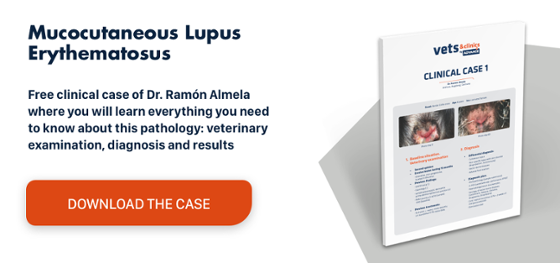Canine pyoderma: predisposing factors and preventive treatment
Bacterial dermatoses are a very significant group of skin infections in the field of veterinary dermatology, especially with regard to dogs. There is a wide variety of clinical presentations, and their diagnosis and subsequent treatment can be difficult.
- In most cases dermatosis is a secondary process due to underlying or concomitant diseases.
- It is important to investigate the primary causes favouring these bacterial skin processes.
- Primary pyoderma rarely develops on healthy skin.
- In principle, correct antibiotic therapy should resolve the problem without any relapses.
Why is pyoderma more prevalent in dogs than in cats or other animals?
Canine pyoderma is one of the main aetiologies behind various skin disorders. The reasons for its higher prevalence in comparison with other animals are not fully understood. It has been suggested that some physiological and anatomical factors are involved, such as:
- Resident bacterial flora
- Stratum corneum thickness
- No follicular plug
- Welfare and behavioural factors such as hygiene and licking
- Numerous case studies into pruritic diseases that facilitate bacteria fixation and penetration
- High prevalence of canine atopic dermatitis with pruritus and a compromised skin barrier due to a filaggrin deficiency or altered lipid synthesis, among others.
Key point: differentiating between superficial and deep pyoderma
Pyoderma in dogs is usually classified according to its penetration:
Most superficial pyodermas in dogs are caused by Staphylococcus pseudintermedius (90% of cases). This bacterium is considered resident biota in a dog’s skin in areas such as the nostrils, oropharynx and anal sphincter.
Less frequently, other Gram-negative bacteria such as Proteus and Pseudomonas spp. and coliform bacteria may also be involved, particularly in deep infections.
Factors and pathologies predisposing to pyoderma: hypothyroidism, canine atopic dermatitis, among others
As mentioned, there are predisposing factors for canine pyoderma, as well as primary pathologies that favour bacterial processes in the skin, such as:
- Surface and superficial pyoderma affecting the stratum corneum, intraepidermal layer and skin appendages. For example: intertrigo, impetigo, folliculitis, etc.Deep pyodermas that affect the dermis and may reach the subcutaneous tissue. For example: folliculitis/localised or generalised furunculosis, abscesses, etc.
- Hypersensitivity: Primarily canine atopic dermatitis with the consequent appearance of pruritus, which will irritate the skin promoting the release of proinflammatory cytokines, and abrasions due to self-injury.
- Seborrheic processes: Animals with seborrhoea have more bacteria on their skin, and may also have overgrowth of Malassezia. This is combined with alterations in the superficial lipid layer, leading to inflammation and itching, and occasionally follicular occlusion.
- Endocrinopathies: Hypothyroidism, hyperadrenocorticism, sex hormone imbalance, diabetes.
- Neoplasms such as cutaneous lymphomas.
- Parasitic diseases: such as demodicosis and leishmaniosis.
- Iatrogenic factors due to the use of corticotherapy.
- Others
In dogs with atopic dermatitis, besides the pruritus that triggers self-injury, the skin also has certain compositional deficiencies. A mutation in the filaggrin protein, an essential part of the epidermal barrier, and changes in the synthesis of complex lipids of the stratum corneum debilitate the epidermis of atopic dogs, so they have an increased predisposition to pyoderma.
Treatment of canine pyoderma:how can we reinforce the skin’s protective barrier?
As we have seen, it is essential to maintain skin health, so that it can complete its role as a protective barrier effectively. Measures to reinforce skin health involve both infection control and regenerating the skin from the inside.
We can help maintain good skin condition with, for example, good antiparasite control, baths with appropriate shampoos in prone animals, grooming, etc.
Suitable nutrition to help the skin maintain correct moisture levels, a healthy lipid layer and a good balance of fatty acids is essential for keeping it in good condition.
Regenerating the skin and reducing the threshold of pruritus through diet has been very successful in dermatological clinical practice, especially in patients with atopic dermatitis, where lipid quantity and composition are affected. Reinforcement with essential fatty acids and aloe vera has proven effective in controlling the disease.
Bibliography
-
Ralf S. Mueller, Catedrático, Eric Guaguère. Aspectos clínicos y de diagnóstico de la pioderma canina. [Clinical aspects and diagnosis of canine pyoderma.] PV ARGOS 13/2016. Available at: argos.portalveterinaria.com/imprimir-noticia.asp?noti=676
-
LLUIS FERRER, PhD, DVM, CELINA TORRE, PhD, DVM; LLUIS VILASECA, DVM; NURIA SANCHEZ, DVM. Research reports.CANINE ATOPIC DERMATITIS (CAD)
-
CESAR L. YOTTI ÁLVAREZ, Novedades en el diagnóstico y tratamiento de la Pioderma canina. Pequeños animales. [Advances in the diagnosis and treatment of canine pyoderma. Small animals.] Available at: http://www.colvema.org/pdf/1215pioderma.pdf
-
Reviewed by Pedro Javier Sancho Forrellad, AVEPA-accredited dermatologist.


